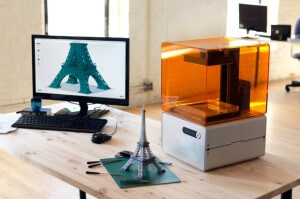3D means three-dimensional, i.e. something that has width, height and depth/length. Our physical environment in which we move everyday is three-dimensional. But thinking of a printer that can print 3-dimentional object amuses us. 3D printing turns computer models into real physical objects which means it can be depicted as a mysterious and seemingly magical process. This technology creates a 3-dimensional object by laying down multiple layers of a material. It takes different materials, from biodegradeable plastic filament to Nylon, melts it into thin layers onto a surface, moves up and prints another layer. Repeating this process layer upon layer, we are left with a physical object. 3D printing is also considered distinct from traditional machining techniques, which mostly rely on the removal of material by methods such as cutting or drilling called subtractive processes. Since this process is in contrast to traditional subtractive manufacturing, it is known as additive manufacturing. Three-dimensional printing has been widely used in industrial contexts for more than two decades. While 3D printing technology has been around since the 1980s as Chuck Hull invented and patented stereolithography (also known as solid imaging) in the mid-1980s, when he founded 3D Systems, Inc., it was not until the early 2010s that the printers became widely available commercially and has captured the public eye.
The first stage of 3D printing is to make a virtual design of the object that can be made in two ways. Firstly with digital modeling — that is, with computer aided design (CAD which involves the use of computer hardware and graphics and enables the designer to quickly produce very accurate and realistic images of products to be manufactured) or animation modeling software and secondly with 3D scanner by copying an existing object. Now the 3D modeling program slices the final model into hundreds or thousands of horizontal layers and is uploaded in the 3D printer.Next we have to choose a specific material depending on the printer as rubber, plastics, paper,metals, ceramic or glass powders etc which is used to prepear the final object. Every 3D printer use a particular technology to release this raw material. There are commonly three technologies used here which are Selective laser sintering (SLS), fused deposition modeling (FDM) and stereolithography (SLA).
 Selective laser sintering uses a high power laser that scans the cross-section of the design generated by the 3D modeling program and selectively fuses the powdered material such as plastic, metal, ceramic or glass powders on the surface of a powder bed. Layers are added one after another and the process is repeated until the object is completed. All untouched powder remains as it is and becomes a support structure for the object which is the advantage of this technology. Fused deposition modeling uses plastic filament or metal wire that extrude out of a nozzle to form the design. The the third technology is stereolithography which uses ultraviolet laser beam to solidify photopolymer resin to form the design.
Selective laser sintering uses a high power laser that scans the cross-section of the design generated by the 3D modeling program and selectively fuses the powdered material such as plastic, metal, ceramic or glass powders on the surface of a powder bed. Layers are added one after another and the process is repeated until the object is completed. All untouched powder remains as it is and becomes a support structure for the object which is the advantage of this technology. Fused deposition modeling uses plastic filament or metal wire that extrude out of a nozzle to form the design. The the third technology is stereolithography which uses ultraviolet laser beam to solidify photopolymer resin to form the design.
This 3D Printing technology can be the next big thing in the technology invention. Three-dimensional printing can be used in almost every industry such as design visualization, architecture, engineering, education, healthcare, geospatial, prototyping/CAD, metal casting, entertainment, retail, art and many more. One of the major selling points of 3-D printing is that the process doesn’t require any tooling, which allows designers to think more creatively during the design process. If a designer can dream of an extremely complicated design, it can also be printed. This technology can be used for reconstructing fossils in paleontology, replicating ancient and priceless artifacts in archaeology, reconstructing bones and body parts in forensic pathology and reconstructing heavily damaged evidence acquired from crime scene investigations. Combining different raw materials isn’t always possible beceause of difference in textures of raw materials which make them difficult to combine and high costs involved, but 3-D printing has eliminated many of these limitations. Less wastage, chiep manufacturing and quick production are some of the benefits of using this technology. The cost of 3D printers has decreased dramatically since about 2010, with machines that used to cost $20,000 are costing less than $1,000 now. As the costs of 3D printers have come down they have become more appealing financially in self-manufacturing of personal products.


